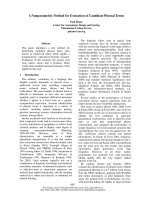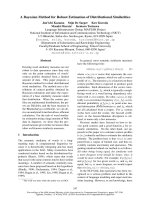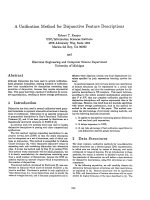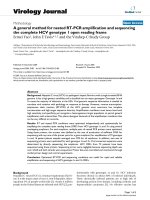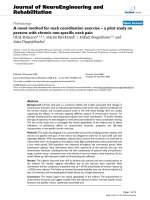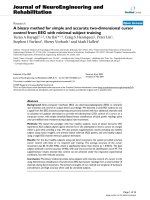Báo cáo toán học: " A novel method for crystalline silicon solar cells with low contact resistance and antireflection coating by an oxidized Mg layer" ppt
Bạn đang xem bản rút gọn của tài liệu. Xem và tải ngay bản đầy đủ của tài liệu tại đây (1.18 MB, 14 trang )
This Provisional PDF corresponds to the article as it appeared upon acceptance. Fully formatted
PDF and full text (HTML) versions will be made available soon.
A novel method for crystalline silicon solar cells with low contact resistance and
antireflection coating by an oxidized Mg layer
Nanoscale Research Letters 2012, 7:32 doi:10.1186/1556-276X-7-32
Jonghwan Lee ()
Youn-Jung Lee ()
Minkyu Ju ()
Kyungyul Ryu ()
Bonggi Kim ()
Junsin Yi ()
ISSN 1556-276X
Article type Nano Express
Submission date 10 September 2011
Acceptance date 5 January 2012
Publication date 5 January 2012
Article URL />This peer-reviewed article was published immediately upon acceptance. It can be downloaded,
printed and distributed freely for any purposes (see copyright notice below).
Articles in Nanoscale Research Letters are listed in PubMed and archived at PubMed Central.
For information about publishing your research in Nanoscale Research Letters go to
/>For information about other SpringerOpen publications go to
Nanoscale Research Letters
© 2012 Lee et al. ; licensee Springer.
This is an open access article distributed under the terms of the Creative Commons Attribution License ( />which permits unrestricted use, distribution, and reproduction in any medium, provided the original work is properly cited.
A novel method for crystalline silicon solar cells with low contact resistance
and antireflection coating by an oxidized Mg layer
Jonghwan Lee
1
, Youn-Jung Lee
1
, Minkyu Ju
1
, Kyungyul Ryu
1
, Bonggi Kim
1
, and Junsin
Yi*
1,2
1
School of Information and Communication Engineering, Sungkyunkwan University, Suwon,
440-746, South Korea
2
Department of Energy Science, Sungkyunkwan University, Suwon, 440-746, South Korea
Corresponding author:
Email addresses:
JL:
Y-JL:
MJ:
KR:
BK:
JY:
Abstract
One of the key issues in the solar industry is lowering dopant concentration of
emitter for high-efficiency crystalline solar cells. However, it is well known that a low
surface concentration of dopants results in poor contact formation between the front Ag
electrode and the n-layer of Si. In this paper, an evaporated Mg layer is used to reduce series
resistance of c-Si solar cells. A layer of Mg metal is deposited on a lightly doped n-type Si
emitter by evaporation. Ag electrode is screen printed to collect the generated electrons.
Small work function difference between Mg and n-type silicon reduces the contact resistance.
During a co-firing process, Mg is oxidized, and the oxidized layer serves as an antireflection
layer. The measurement of an Ag/Mg/n-Si solar cell shows that V
oc
, J
sc
, FF, and efficiency
are 602 mV, 36.9 mA/cm
2
, 80.1%, and 17.75%, respectively. It can be applied to the
manufacturing of low-cost, simple, and high-efficiency solar cells.
Keywords: solar cell; Mg metal film; low-series contact resistance; antireflection coating.
Background
The main objective of the current single crystalline silicon [c-Si] photovoltaic
research is to enhance the efficiency of the solar cell without a too complicated process. One
of the ways to increase the efficiency is to lower the front surface recombination using a low
surface doping concentration. C-Si solar cells with a lowly doped emitter have high short-
circuit current, and the absorption in the blue response region is better. It has been reported
that the recombination velocity of the emitter layer with a sheet resistance of 100 Ω/sq is
60,000 cm/s while that of the emitter with a 45-Ω/sq sheet resistance is 180,000 cm/s [1].
The quality of metal contact can also affect the solar cell efficiency. For commercial
c-Si solar cells, the front contact metallization is fabricated by the screen printing of Ag paste
in grid patterns [2, 3]. The screen printed Ag electrodes may reduce the efficiency when
1
operated at concentration levels of more than 1 sun due to high-series resistance. A small
front metal contact area [4, 5] and a low metal density in Ag-screen printed lines contribute to
the high resistance [6]. The presence of a glass frit mostly contributed by SiO
2
in the Ag paste
also results in high metal-semiconductor contact resistivity [7]. Increased resistive power loss
occurs under light and eventually degrades the solar cell efficiency [8]. To reduce the contact
resistance, a selective emitter method is introduced recently. It consists of a lightly doped
emitter to enhance the blue response of solar cells and a heavily doped emitter underneath the
contact to reduce the contact resistance. Although the performance of the selective emitter
solar cell is fairly good, its fabrication process is very complicated, making it difficult for
mass production [9]. To have similar effects without using the selective emitter method, a
barrier material can be introduced between the Ag and Si since it is difficult to get ideal
ohmic contacts with an n-type silicon substrate doped with phosphorus. The contact
resistance is decided by the doping density of impurity and the work function difference
between Si and the metal. To achieve decreased contact resistance, it is important to have a
low work function difference between Si and the metal. One of the good candidates for the
barrier is Mg [10]. In this paper, Mg is inserted between Ag and Si. The effects of Mg on the
contact resistance and the reflectance are investigated.
Methods
Figure 1 shows the processing sequence of the solar cell using the Mg metal. The
substrates used were Czochralski (Cz) and (100) boron-doped, p-type silicon wafers having a
resistivity of 1.5 Ω cm, a thickness of about 200 µm, and a size of 1.5 × 1.5 cm. Initially, the
wafers were textured by a 1% NaOH solution followed by an n+ layer formed by POCl
3
doping. Doping was carried out at 810°C for 7 min, and the resulting sheet resistance was
100 Ω/sq. A phosphorous silicate glass layer was removed and rinsed with a 10%
hydrofluoric acid [HF] solution followed by de-ionized [DI] water. The wafers were then
dipped in the HF solution for 30 s followed by DI water rinsing and drying. Thin Mg layers
having thicknesses of 200, 300, and 400 Å were deposited using a thermal evaporator. The
thicknesses of Mg layers were monitored by alpha-step. The amount of Mg used was easily
controlled using Mg pellets that weighed 0.1 g each. The front electrode was screen printed
with a conventional Ag paste; the rear side was printed with an Al paste. The front and rear
electrodes were dried with an infrared [IR] belt furnace at 150°C. During the drying
processes, the Mg layer was oxidized. After the first oxidation, the lifetime was measured
with a Sinton WCT-120 (Boulder, CO, USA) by quasi-steady-state photoconductance decay
[11]. The reflectance was measured using a Sinton S-3100 UV-visible spectrometer.
Finally,
co-firing of the front-side and backside electrodes was done in a four-zone IR belt furnace
with peak temperatures ranging from 725°C to 850°C. The region where Ag is in contact
with Mg formed an electrode having very low contact resistance. The rest of the wafer was
covered with oxidized Mg acting as antireflection coating [ARC] The illuminated current-
voltage characteristics under the global solar spectrum of AM 1.5 at 25°C, dark current-
voltage [DIV] characteristics, and the internal quantum efficiency [IQE] of each cell were
studied.
Results and discussion
The cross section through the contact shows that the screen printed Ag electrode is in
contact with the pure Mg metal layer on Si, resulting in low contact resistance. The rest of the
Mg part undergoes an oxidation process becoming MgO, acting as an ARC layer. The
2
passivation capabilities of MgO layers formed under various experimental conditions are
investigated.
In the case of the lightly doped silicon (N
D
< 17 cm
−3
), the current flow at the
interface is mostly decided by thermion emission, while field emission is the main
mechanism in the case of the heavily doped silicon (N
D
> 17 cm
−3
). In both cases, the most
important factor that affects the current flow is the work function difference between Si and
metal. A lightly doped emitter results in increased contact resistance between contact finger
and n-Si. Since the screen printed Ag metal paste forms too high potential barrier to form an
ohmic contact with an n+ region, a new material can be inserted between Ag and Si to form
low barrier height (Φ
B
) and thus to reduce the contact resistance. Among various materials,
Mg metal is selected to lower the contact resistance. The transfer length method [TLM] is
commonly used to model the planar metal-semiconductor contact, allowing important contact
parameters such as contact resistance R
c
(in ohms), specific contact resistivity ρ
c
(in ohm
centimeter squared), and the semiconductor sheet resistance beneath the contact R
s
(in ohm
centimeters). The TLM consists of sets of resistors representing the metal, diffusion, and
interfacial layers of a contact [12]. The contact resistance between Mg and n-Si can be
extrapolated by the following formula:
T c c
/ 2
R d z R
ρ
= + , (1)
where R
T
is the total resistance, and R
c
is the contact resistance. The total resistance is
measured for various contact spacings; R
c
and R
T
are plotted as functions of d. The intercept
at d = 0 is R
T
= 2R
c
, giving the contact resistance. To calculate the contact resistance, Mg was
evaporated on the n-Si wafer, and the Ag paste was printed on the Si wafer for reference. The
contact resistances of Mg/Si and Ag/Si were measured by the TLM method (Figure 2). The
contact resistivity of the Mg/Si system was characterized to be 9.535 × 10
−3
Ω cm
2
which is
even lower than that of Ag/Si, 8.64 × 10
−
2 Ω cm
2
. It was found that Mg/Si was suitable for a
high-efficiency solar cell application.
Figure 3 shows the carrier lifetimes of Si wafers with different Mg thicknesses (200
to 400 Å) and sintering steps. After the first oxidation, the lifetimes of Mg200, Mg300, and
Mg400 were 13.78, 11.84, and 10.9 µs, respectively. The second oxidation does not affect the
lifetime much, showing that the oxidation process at 150°C does not contribute to the
oxidization of Mg. However, a sharp increase in the lifetime is seen after the last oxidation
especially in the case of Mg200. The lifetimes of Mg200, Mg300, and Mg400 increase from
13.79, 11.84, and 10.95 µs to 32.27, 24.35, and 20.03 µs, respectively. When the deposited
layer of the Mg metal is thin, the thickness of MgO formed after the oxidation process is also
thin and does not serve as a good passivation or ARC layer. It shows that the best passivation
is obtained when the thickness of the Mg metal is around 200 Å. As the amount of Mg
increases, the resistance increases and the passivation deteriorates. From the results, a 200-Å
thickness of Mg is required to form a desired dense MgO layer [13].
Figure 4 shows the dependence of reflectance on Mg thickness and oxidation steps.
Before the oxidation, the reflectance of the Mg metal increases as the thickness increases.
The solar cell current cannot be measured because of the high reflectance. To solve this
problem, Mg is oxidized and MgO is formed. The reflectance of Mg is decreased
dramatically after the oxidation. The reflectances of Mg200, Mg300, and Mg400 decrease
from 25%, 31.62%, and 47.05% to 8.75%, 7.84% and 5.41%, respectively. This shows that
3
the optimum thickness of the Mg metal which minimizes the reflectance at this wavelength
region has been deposited successfully. The optimized thickness of the Mg metal layer is
extracted from the following formula:
0
1
4
n d
λ
× = , (2)
where λ
0
is 550 nm (where the strongest intensity of sunlight is emitted), n
1
is the refractive
index of MgO (which is equal to 1.74), and d is the thickness of the ARC layer. Thicker MgO
results in less reflectance as its thickness gets close to 79 nm which is reported to be an
optimized thickness of MgO for the ARC layer of solar cells [13]. Figure 5 and Table 1 show
the DIV measured. The current is measured in the potential range of 0 to 0.8 V. The current
of the PN junction diode can be separated into two regions: the quasi-neutral region (n
1
) and the
space-charge region (n
2
) recombination/generation [14]. In the two-diode model, this deviation
is taken into account by including a second diode. The second diode expresses generation and
recombination currents within the space-charge region. When the ideality factor of the second
diode deviates far from 2, leakage current increases, parallel resistance [R
sh
] decreases, and
series resistance [R
s
] increases. Increased leakage current and decreased R
sh
cause a decrease
in the short-circuit current density [J
sc
]. Increased R
s
and decreased R
sh
result in a sharp
decline in the fill factor [FF]. In Table 1, it is shown that the leakage current gets higher as
the thickness of the Mg metal increases. This is due to the fact that a thicker Mg metal digs
more into the Si substrate and results in poor solar cell performance. The extracted optimized
conditions of the Mg metal layer are applied to the c-Si solar cell, and its properties are
measured. Figure 6 and Table 2 show the sun-open-circuit voltage [V
oc
] characteristics of
solar cells with different Mg thicknesses. It is seen that the cell with Mg200 Å deposition has
the best efficiency. The V
oc
of the cell is 602 mV, and the J
sc
is 36.9 mA/cm
2
. Relatively low
V
oc
value is obtained, and it is attributed to the reduced band bending caused by a low doping
concentration of the emitter layer. However, the J
sc
value is relatively high due to the effect
of the high R
s
emitter and the MgO layer collecting more carriers which would have usually
been recombined at the front surface. Consequently, with this high J
sc
value, the high-R
s
c-Si
solar cell reaches a conversion efficiency of 17.75%.
Generally, the quantum efficiency is reduced by recombination. The same
mechanisms which affect the collection probability also affect the quantum efficiency. Since
blue light is absorbed very close to the surface, high front surface recombination will affect
the blue portion of the quantum efficiency. Thus, a good front surface passivation is
important. Green light is absorbed in the bulk of a solar cell, and a low diffusion length
reduces the quantum efficiency in the green portion of the spectrum. The quantum efficiency
can be viewed as the collection probability due to the generation profile of a single
wavelength, integrated over the device thickness and normalized to the incident number of
photons. From the IQE graph, not presented here, from a wavelength of λ = 400 to 1,100 nm,
the best blue response is seen for the cell with a 200-Å-thick Mg layer, suggesting that it has
the most decreased recombination velocity at the surface.
Conclusion
In conventional solar cells, a screen printed Ag paste is often used for front
metallization materials. It induces the increase of contact resistance due to high barrier height
between Ag and n-type Si. To solve this problem, Mg metal is evaporated before the
formation of Ag electrode. After the Ag electrode is screen printed, a firing step is taken. As a
4
result, a low contact resistance is obtained at the Ag/Mg/Si electrode. Since the exposed Mg
metal goes through oxidation during firing, it becomes MgO serving as an ARC layer. Since
the whole emitter is lightly doped (100 Ω/sq), the surface recombination velocity is reduced
by the simple and low-cost fabrication process.
Optimum thickness of Mg has been investigated. It is found that the lifetime is 32.27
µs and the reflectance is 8.75% when the Mg thickness is 200 Å. This condition is applied to
a 100-Ω/sq c-Si solar cell process to have low contact resistance with good ARC. The
measurement of an Ag/Mg/n-Si solar cell shows that V
oc
, J
sc
, FF, and efficiency are 602 mV,
36.9 mA/cm
2
, 80.1%, and 17.75%, respectively.
Competing interests
The authors declare they have no competing interests.
Authors' contributions
JL proposed the original idea, carried out the synthesis and analysis, and wrote the first draft
of the manuscript. MJ carried out most of the experiments with JL and shared his idea with
the other authors. KR, Y-JL, and BK detailed the original idea and modified the first draft of
the manuscript. JY designed and coordinated the whole work and finalized the manuscript.
All authors read and approved the final manuscript
Acknowledgments
This work was supported by the Priority Research Centers Program through the National
Research Foundation of Korea (NRF) funded by the Ministry of Education, Science and
Technology (2011-0018397). This work was supported financially by the National Research
Laboratory (NRL-ROA-2007-000-1002).
References
1. Hilali MM, Nakayashiki K, Ebong A, Rohatgi A: High-efficiency (19%) screen-printed
textured cells on low-resistivity float-zone silicon with high sheet-resistance emitters.
Prog Photovolt Res Appl 2006, 14:135-144.
2. Porter LM, Teicher A, Meier DL: Phosphorus-doped, silver-based pastes for self-
doping ohmic contacts for crystalline silicon solar cells. Sol Energy Mater Sol Cells
2002, 73:209-219.
3. Hilali MM, Nakayashiki K, Khadilkar C, Reedy RC, Rohatgi A, Shaikh A, Kim S,
Sridharan S: Effect of Ag particle size in thick-film Ag paste on the electrical and
physical properties of screen printed contacts and silicon solar cells. J Electrochem
Soc 2006, 153:A5-A11.
4. Pysch D, Mette A, Glunz SW: A review and comparison of different methods to
determine the series resistance of solar cells. Solar Energy Materials and Solar Cells
2007, 91:1698-1706.
5. Vinod PN: Evaluation of the ohmic properties of the silver metal contacts of an
improved sintering process on the multicrystalline silicon solar cells. In Proceedings of
the International Workshop on Physics of Semiconductor Devices: December 16-20 2007;
Mumbai. IEEE 2007:953-956.
6. Coello J, Castro M, Antón I, Sala G, Vázquez MA: Conversion of commercial Si solar
cells to keep their efficient performance at 15 suns. Prog Photovoltaics Res Appl 2004,
12:323-331.
5
7. Hilali MM, Sridharan S, Khadilkar C, Shaikh A, Rohatgi A, Steve KIM: Effect of glass
frit chemistry on the physical and electrical properties of thick-film Ag contacts for
silicon solar cells. J Electro Mater 2006, 35:2041-2047.
8. Chaudhari VA, Solanki CS: A novel two step metallization of Ni/Cu for low
concentrator c-Si solar cells. Sol Energy Mater Sol Cells 2010, 94:2094-2101.
9. Hörteis M, Glunz SW: Fine line printed silicon solar cells exceeding 20% efficiency.
Prog Photovoltaics Res Appl 2008, 16:555-560.
10. Schroder DK, Meier DL: Solar cell contact resistance–a review. Electron Devices IEEE
Trans 1984, 31:637-647.
11. Sinton RA, Cuevas A: Contactless determination of current-voltage characteristics
and minority-carrier lifetimes in semiconductors from quasi-steady-state
photoconductance data. Appl Phys Lett 1996, 69:2510-2512.
12. Reeves GK, Harrison HB: Obtaining the specific contact resistance from transmission
line model measurements. Electron Device Lett IEEE 1982, 3:111-113.
13. Lee W, Cho H, Cho B, Kim J, Kim Y-S, Jung W-G, Kwon H, Lee J, Reucroft PJ, Lee C,
Lee J: Factors affecting passivation of Cu(Mg) alloy films. J Electrochem Soc 2000,
147:3066-3069.
14. Charles JP, Abdelkrim M, Muoy YH, Mialhe P: A practical method of analysis of the
current-voltage characteristics of solar cells. Sol Cells 1981, 4:169-178.
Figure 1. A flow diagram of the processed solar cells with Mg evaporation and
oxidation.
Figure 2. TLM results of (a) the Mg/n-Si contact resistance and (b) the Ag/n-Si
contact resistance.
Figure 3. Carrier lifetimes of Si wafers with different Mg thicknesses and
sintering steps. Mg200, thickness of Mg is 200 Å; Mg300, thickness of Mg is 300 Å;
Mg400, thickness of Mg is 400 Å.
Figure 4. Dependence of reflectance on the Mg thickness and oxidation steps.
Figure 5. Effect of Mg thickness on the DIV of the processed solar cells.
Figure 6. Sun-V
oc
data of the processed solar cells with different Mg thicknesses.
Table 1. Series resistance, shunt resistance, first ideality factor, and second ideality
factor of processed solar cells
Mg200 Å
Mg300 Å
Mg400 Å
R
s
(Ω cm) 1.04 1.36 1.65
R
sh
(Ω) 24,948.2 984.8 182.8
n
1
1.38 1.67 4.08
n
2
2.03 9.02 8.01
J
oe
(A/cm
2
) 5.22E-09 6.44E-08 1.51E-04
R
s
, series resistance; R
sh
, parallel resistance; n
1
, quasi-neutral region; n
2
, space-charge region;
J
oe
, saturation current density.
6
Table 2. Sun-V
oc
parameters of the processed solar cells with different Mg thicknesses
without an oxidation step
Sample
V
oc
(mV)
J
sc
(mA/cm
2
)
FF
(%)
EFF
(%)
Mg200 Å 602 36.9 80.1 17.75
Mg300 Å 598 36 78.6 16.99
Mg400 Å 600 35 78.4 16.67
V
oc
, open-circuit voltage; J
sc
, short-circuit current density; FF, fill factor; EFF, efficiency.
Figure 1
(a)
(b)
Figure 2
Mg200 Mg300 Mg400 Ref. SiNx
0
5
10
15
20
25
30
35
Fir st dry
Second dry
Fir ing
MCD 3X10
15
Measur ed Lifetime
Figure 3
300 400 500 600 700 800 900 1000 1100
0
5
10
15
20
25
30
Wavelength (nm)
Reflectance (% )
Mg 200 8.75%
Mg 300 8.84%
Mg 400 5.41%
Figure 4
0.0 0.2 0.4 0.6 0.8
10
-7
10
-6
10
-5
10
-4
10
-3
10
-2
10
-1
Voltage (V)
Dar k cur rent (A)
Mg 200
Mg 300
Mg 400
Figure 5
0.0 0.1 0.2 0.3 0.4 0.5 0.6 0.7
0
5
10
15
20
25
30
35
40
Cur r ent mA/cm
2
Voltage (V)
Mg 200
Mg 300
Mg 400
Figure 6

